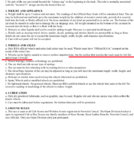So, this is our second year racing and last year we did little to no speed prep other than some hobby graphite on the axles. We ended up with the CoM much to close to the rear (behind or right above the rear axles) and had a deadly shimmy in the front end due to the lack of weight. We were a full second or more behind some of the cars we raced.
Our Pack has some fairly strict rules compared to many that are posted on here. I was hoping I could post a few of them and get some feeling for interpretation of them. Any thoughts on these are greatly appreciated.
The ones that are causing me the most issues are:
Rule # 1 - Insert axles only into the grooves provided on the wood block of the car. Long wheelbase cars are not allowed. Applying wood putty in the grooves and using a drill press to make holes to insert the axles is prohibited.
Would you drill your own holes on the opposite side of the block and cut slots, drill above the slots and then sand down the bottom of the kit to get the required 3/8" ground clearance or use the existing slots and hope for the best?
I did buy a silver bullet and have tested on three blocks so far. When drilling into the slot, I tend to get to much play with a #44 bit. I was using a Dremel Workstation and not a drill press on the initial tests and I've corrected that mistake by getting a drill press for any further blocks that I drill.
Rule #2 - Only dry powder lubricants, such as graphite, may be used. Regular oils and silicone sprays are prohibited and may soften the plastic wheels.
Would you immediately discount using Pledge before applying the graphite due to this rule? Pledge has silicone in it, but would it be illegal to use that as the final polishing step and not as lubricant applied on race day.
Question #1 - Even if I don't do a rail runner type setup, would you ever consider NOT raising one of the front wheels? This is allowed by our rules and I believe the answer is raise it no matter what, but I figured that I'd ask. I'm using a silver bullet to drill holes and I believe I would do the rear wheels with camber and the DFW straight in this type of setup. Is that correct? I may decide to try a rail runner, but I wanted to get a car running well before I tried that.
We have other rules that explicitly prevent the use of any axles or wheels other than ones identical to the ones that come in the kit. I know that doesn't make for the fastest car, but I've read enough on here that I'm pretty comfortable with what I need to do there to keep well within the rules and still be competitive.
Thanks for any opinions or advice! The site has taught me a lot so far, I was just hoping to get some opinions on the use of the pre-existing slots before I chew through more kits.
Our Pack has some fairly strict rules compared to many that are posted on here. I was hoping I could post a few of them and get some feeling for interpretation of them. Any thoughts on these are greatly appreciated.
The ones that are causing me the most issues are:
Rule # 1 - Insert axles only into the grooves provided on the wood block of the car. Long wheelbase cars are not allowed. Applying wood putty in the grooves and using a drill press to make holes to insert the axles is prohibited.
Would you drill your own holes on the opposite side of the block and cut slots, drill above the slots and then sand down the bottom of the kit to get the required 3/8" ground clearance or use the existing slots and hope for the best?
I did buy a silver bullet and have tested on three blocks so far. When drilling into the slot, I tend to get to much play with a #44 bit. I was using a Dremel Workstation and not a drill press on the initial tests and I've corrected that mistake by getting a drill press for any further blocks that I drill.
Rule #2 - Only dry powder lubricants, such as graphite, may be used. Regular oils and silicone sprays are prohibited and may soften the plastic wheels.
Would you immediately discount using Pledge before applying the graphite due to this rule? Pledge has silicone in it, but would it be illegal to use that as the final polishing step and not as lubricant applied on race day.
Question #1 - Even if I don't do a rail runner type setup, would you ever consider NOT raising one of the front wheels? This is allowed by our rules and I believe the answer is raise it no matter what, but I figured that I'd ask. I'm using a silver bullet to drill holes and I believe I would do the rear wheels with camber and the DFW straight in this type of setup. Is that correct? I may decide to try a rail runner, but I wanted to get a car running well before I tried that.
We have other rules that explicitly prevent the use of any axles or wheels other than ones identical to the ones that come in the kit. I know that doesn't make for the fastest car, but I've read enough on here that I'm pretty comfortable with what I need to do there to keep well within the rules and still be competitive.
Thanks for any opinions or advice! The site has taught me a lot so far, I was just hoping to get some opinions on the use of the pre-existing slots before I chew through more kits.


